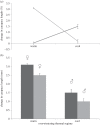A novel hypothesis for the adaptive maintenance of environmental sex determination in a turtle
- PMID: 25009063
- PMCID: PMC4100507
- DOI: 10.1098/rspb.2014.0831
A novel hypothesis for the adaptive maintenance of environmental sex determination in a turtle
Abstract
Temperature-dependent sex determination (TSD) is widespread in reptiles, yet its adaptive significance and mechanisms for its maintenance remain obscure and controversial. Comparative analyses identify an ancient origin of TSD in turtles, crocodiles and tuatara, suggesting that this trait should be advantageous in order to persist. Based on this assumption, researchers primarily, and with minimal success, have employed a model to examine sex-specific variation in hatchling phenotypes and fitness generated by different incubation conditions. The unwavering focus on different incubation conditions may be misplaced at least in the many turtle species in which hatchlings overwinter in the natal nest. If overwintering temperatures differentially affect fitness of male and female hatchlings, TSD might be maintained adaptively by enabling embryos to develop as the sex best suited to those overwintering conditions. We test this novel hypothesis using the painted turtle (Chrysemys picta), a species with TSD in which eggs hatch in late summer and hatchlings remain within nests until the following spring. We used a split-clutch design to expose field-incubated hatchlings to warm and cool overwintering (autumn-winter-spring) regimes in the laboratory and measured metabolic rates, energy use, body size and mortality of male and female hatchlings. While overall mortality rates were low, males exposed to warmer overwintering regimes had significantly higher metabolic rates and used more residual yolk than females, whereas the reverse occurred in the cool temperature regime. Hatchlings from mixed-sex nests exhibited similar sex-specific trends and, crucially, they were less energy efficient and grew less than same-sex hatchlings that originated from single-sex clutches. Such sex- and incubation-specific physiological adaptation to winter temperatures may enhance fitness and even extend the northern range of many species that overwinter terrestrially.
Keywords: Charnov–Bull; Chrysemys picta; metabolism; overwinter; temperature-dependent sex determination; turtle.
© 2014 The Author(s) Published by the Royal Society. All rights reserved.
Figures

 of male (diamonds) and female (squares) hatchling painted turtles in the warm (solid line) and cool (dashed line) overwintering regimes (±s.e).
of male (diamonds) and female (squares) hatchling painted turtles in the warm (solid line) and cool (dashed line) overwintering regimes (±s.e).

Similar articles
-
Potential sources of intra-population variation in the overwintering strategy of painted turtle (Chrysemys picta) hatchlings.J Exp Biol. 2014 Dec 1;217(Pt 23):4174-83. doi: 10.1242/jeb.111120. Epub 2014 Oct 16. J Exp Biol. 2014. PMID: 25324341
-
Environmentally induced phenotypic plasticity explains hatching synchrony in the freshwater turtle Chrysemys picta.J Exp Zool A Ecol Integr Physiol. 2018 Jul;329(6-7):362-372. doi: 10.1002/jez.2217. Epub 2018 Sep 7. J Exp Zool A Ecol Integr Physiol. 2018. PMID: 30192440
-
Physiological ecology of overwintering in the hatchling painted turtle: multiple-scale variation in response to environmental stress.Physiol Biochem Zool. 2004 Jan-Feb;77(1):74-99. doi: 10.1086/378141. Physiol Biochem Zool. 2004. PMID: 15057719
-
The ecology of overwintering among turtles: where turtles overwinter and its consequences.Biol Rev Camb Philos Soc. 2006 Aug;81(3):339-67. doi: 10.1017/S1464793106007032. Epub 2006 May 15. Biol Rev Camb Philos Soc. 2006. PMID: 16700968 Review.
-
Physiological ecology of overwintering in hatchling turtles.J Exp Zool A Ecol Genet Physiol. 2008 Jul 1;309(6):297-379. doi: 10.1002/jez.460. J Exp Zool A Ecol Genet Physiol. 2008. PMID: 18484621 Review.
Cited by
-
Identification of candidate piRNAs in the gonads of Paralichthys olivaceus (Japanese flounder).Zool Res. 2016 Sep 18;37(5):301-6. doi: 10.13918/j.issn.2095-8137.2016.5.301. Zool Res. 2016. PMID: 27686790 Free PMC article.
-
The functional significance of residual yolk in lizards.Curr Zool. 2022 Dec 7;69(2):192-199. doi: 10.1093/cz/zoac098. eCollection 2023 Apr. Curr Zool. 2022. PMID: 37091998 Free PMC article.
-
Sex determination systems in reptiles are related to ambient temperature but not to the level of climatic fluctuation.BMC Evol Biol. 2020 Aug 17;20(1):103. doi: 10.1186/s12862-020-01671-y. BMC Evol Biol. 2020. PMID: 32807071 Free PMC article.
-
Geographic variation in thermal sensitivity of early life traits in a widespread reptile.Ecol Evol. 2019 Feb 14;9(5):2791-2802. doi: 10.1002/ece3.4956. eCollection 2019 Mar. Ecol Evol. 2019. PMID: 30891217 Free PMC article.
-
Context-dependent thermolability of sex determination in a lacertid lizard with heteromorphic sex chromosomes.Biol Open. 2023 May 15;12(5):bio059967. doi: 10.1242/bio.059967. Epub 2023 May 16. Biol Open. 2023. PMID: 37191107 Free PMC article.
References
-
- Emlen DJ. 1994. Environmental control of horn length dimorphism in the beetle Onthopagus acuminatus (Coleoptera: Scarabaeidae). Proc. R. Soc. Lond. B 256, 131–136. (10.1098/rspb.1994.0060) - DOI
Publication types
MeSH terms
LinkOut - more resources
Full Text Sources
Other Literature Sources

